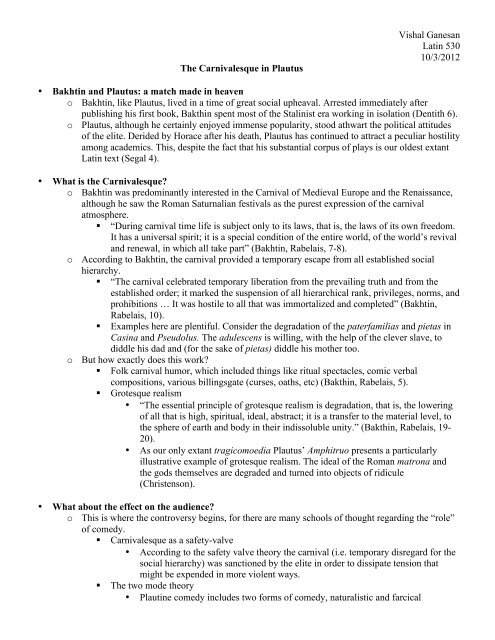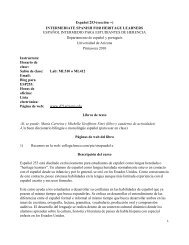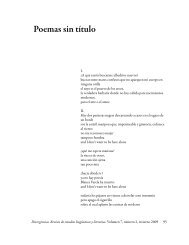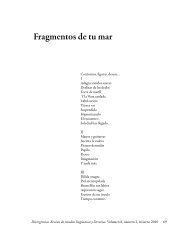The Carnivalesque/Bakhtin in Plautus
The Carnivalesque/Bakhtin in Plautus
The Carnivalesque/Bakhtin in Plautus
Create successful ePaper yourself
Turn your PDF publications into a flip-book with our unique Google optimized e-Paper software.
<strong>The</strong> <strong>Carnivalesque</strong> <strong>in</strong> <strong>Plautus</strong><br />
Vishal Ganesan<br />
Lat<strong>in</strong> 530<br />
10/3/2012<br />
• <strong>Bakht<strong>in</strong></strong> and <strong>Plautus</strong>: a match made <strong>in</strong> heaven<br />
o <strong>Bakht<strong>in</strong></strong>, like <strong>Plautus</strong>, lived <strong>in</strong> a time of great social upheaval. Arrested immediately after<br />
publish<strong>in</strong>g his first book, Bakth<strong>in</strong> spent most of the Stal<strong>in</strong>ist era work<strong>in</strong>g <strong>in</strong> isolation (Dentith 6).<br />
o <strong>Plautus</strong>, although he certa<strong>in</strong>ly enjoyed immense popularity, stood athwart the political attitudes<br />
of the elite. Derided by Horace after his death, <strong>Plautus</strong> has cont<strong>in</strong>ued to attract a peculiar hostility<br />
among academics. This, despite the fact that his substantial corpus of plays is our oldest extant<br />
Lat<strong>in</strong> text (Segal 4).<br />
• What is the <strong>Carnivalesque</strong>?<br />
o <strong>Bakht<strong>in</strong></strong> was predom<strong>in</strong>antly <strong>in</strong>terested <strong>in</strong> the Carnival of Medieval Europe and the Renaissance,<br />
although he saw the Roman Saturnalian festivals as the purest expression of the carnival<br />
atmosphere.<br />
§ “Dur<strong>in</strong>g carnival time life is subject only to its laws, that is, the laws of its own freedom.<br />
It has a universal spirit; it is a special condition of the entire world, of the world’s revival<br />
and renewal, <strong>in</strong> which all take part” (<strong>Bakht<strong>in</strong></strong>, Rabelais, 7-8).<br />
o Accord<strong>in</strong>g to <strong>Bakht<strong>in</strong></strong>, the carnival provided a temporary escape from all established social<br />
hierarchy.<br />
§ “<strong>The</strong> carnival celebrated temporary liberation from the prevail<strong>in</strong>g truth and from the<br />
established order; it marked the suspension of all hierarchical rank, privileges, norms, and<br />
prohibitions … It was hostile to all that was immortalized and completed” (<strong>Bakht<strong>in</strong></strong>,<br />
Rabelais, 10).<br />
§ Examples here are plentiful. Consider the degradation of the paterfamilias and pietas <strong>in</strong><br />
Cas<strong>in</strong>a and Pseudolus. <strong>The</strong> adulescens is will<strong>in</strong>g, with the help of the clever slave, to<br />
diddle his dad and (for the sake of pietas) diddle his mother too.<br />
o But how exactly does this work?<br />
§ Folk carnival humor, which <strong>in</strong>cluded th<strong>in</strong>gs like ritual spectacles, comic verbal<br />
compositions, various bill<strong>in</strong>gsgate (curses, oaths, etc) (Bakth<strong>in</strong>, Rabelais, 5).<br />
§ Grotesque realism<br />
• “<strong>The</strong> essential pr<strong>in</strong>ciple of grotesque realism is degradation, that is, the lower<strong>in</strong>g<br />
of all that is high, spiritual, ideal, abstract; it is a transfer to the material level, to<br />
the sphere of earth and body <strong>in</strong> their <strong>in</strong>dissoluble unity.” (Bakth<strong>in</strong>, Rabelais, 19-<br />
20).<br />
• As our only extant tragicomoedia <strong>Plautus</strong>’ Amphitruo presents a particularly<br />
illustrative example of grotesque realism. <strong>The</strong> ideal of the Roman matrona and<br />
the gods themselves are degraded and turned <strong>in</strong>to objects of ridicule<br />
(Christenson).<br />
• What about the effect on the audience?<br />
o This is where the controversy beg<strong>in</strong>s, for there are many schools of thought regard<strong>in</strong>g the “role”<br />
of comedy.<br />
§ <strong>Carnivalesque</strong> as a safety-valve<br />
• Accord<strong>in</strong>g to the safety valve theory the carnival (i.e. temporary disregard for the<br />
social hierarchy) was sanctioned by the elite <strong>in</strong> order to dissipate tension that<br />
might be expended <strong>in</strong> more violent ways.<br />
§ <strong>The</strong> two mode theory<br />
• Plaut<strong>in</strong>e comedy <strong>in</strong>cludes two forms of comedy, naturalistic and farcical
Vishal Ganesan<br />
Lat<strong>in</strong> 530<br />
10/3/2012<br />
<strong>The</strong> <strong>Carnivalesque</strong> <strong>in</strong> <strong>Plautus</strong><br />
• “S<strong>in</strong>ce everyone is subord<strong>in</strong>ated <strong>in</strong> some sense, the desire to participate<br />
imag<strong>in</strong>atively <strong>in</strong> staged rebellion does not divide the audience (say, between<br />
masters and slaves or between fathers and sons) but unifies it” (McCarthy 20).<br />
• Recall the end<strong>in</strong>g of Pseudolus (Ps. 1327-29), <strong>in</strong> which slave and master<br />
leave the stage to dr<strong>in</strong>k together. <strong>The</strong> question of Pseudolus’ liberation<br />
rema<strong>in</strong>s unresolved, though the power dynamic between the two<br />
characters is undeniably altered.<br />
§ Alternatives?<br />
• <strong>The</strong> safety-valve theory is <strong>in</strong>tuitively appeal<strong>in</strong>g, but ultimately unpersuasive. It’s<br />
hard to believe that these performances had no residual impact on the audience<br />
members.<br />
• <strong>Bakht<strong>in</strong></strong> described the carnival as a “utopia,” a glimpse <strong>in</strong>to what the world could<br />
be like (<strong>Bakht<strong>in</strong></strong>, Rabeleis, 9).
Bibliography<br />
<strong>The</strong> <strong>Carnivalesque</strong> <strong>in</strong> <strong>Plautus</strong><br />
Vishal Ganesan<br />
Lat<strong>in</strong> 530<br />
10/3/2012<br />
Batstone, W. 2005. “Plaut<strong>in</strong>e Farce and Plaut<strong>in</strong>e Freedom: An Essay on the Value of Metatheatre,” pp. 13-46 <strong>in</strong><br />
Batstone, W. and G. Tissol, eds., Def<strong>in</strong><strong>in</strong>g Genre and Gender <strong>in</strong> Lat<strong>in</strong> Literature: Essays Presented to<br />
William S. Anderson on his Seventy-Fifth Birthday. New York.<br />
Christenson, D. M. 2001. “Grotesque Realism <strong>in</strong> <strong>Plautus</strong>' Amphitruo,” Classical Journal 96: 243-60.<br />
<strong>Bakht<strong>in</strong></strong>, M. 1981. <strong>The</strong> Dialogic Imag<strong>in</strong>ation: Four Essays by M. M. <strong>Bakht<strong>in</strong></strong>, trs. C. Emerson and M. Holquist.<br />
Aust<strong>in</strong>, TX.<br />
<strong>Bakht<strong>in</strong></strong>, M. 1984. Rabelais and his World, trs. H. Iswolsky. Bloom<strong>in</strong>gton, IN.<br />
Dentith, S. 1995. <strong>Bakht<strong>in</strong></strong>ian Thought: An Introductory Reader. London.<br />
McCarthy, K. 2000. Slaves, Masters, and the Art of Authority <strong>in</strong> Plaut<strong>in</strong>e Comedy. Pr<strong>in</strong>ceton.<br />
Segal, E. 1987. Roman Laughter. 2nd edition. Oxford.
















